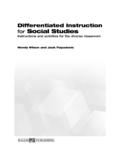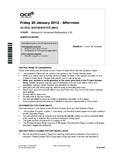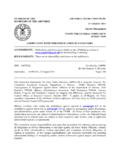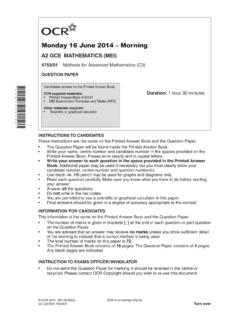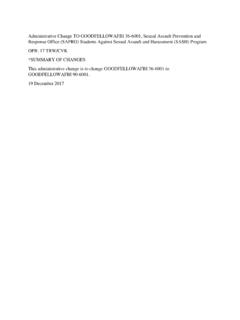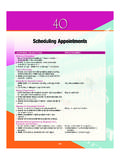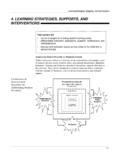Transcription of Differentiated Instruction for English Language Arts
1 Differentiated Instruction for English Language Arts instructions and activities for the diverse classroom Gail Blasser Riley . WALCH EDUCATION. Table of Contents Introduction to Differentiated Instruction .. v Standards for the English Language Arts .. viii Chapter 1: Kicking Off Differentiated Instruction Personal Style in Utilizing Content Lesson 1: Personal Interests, Traits, and Goals.. 1. Lesson 2: Personal Learning Styles .. 6. Lesson 3: Also Known As ( ) .. 11. Lesson 4: Writing Log Sparks.. 14. Chapter 2: Analyzing and Evaluating Content Lesson 5: Ads How Do They Grab You? .. 17. Lesson 6: Power Quotes .. 22. Lesson 7: Shakespeare's Comedies, Tragedies, and Histories .. 27. Lesson 8: Picture This Editorial Cartoons .. 33. Chapter 3: Exercising Creativity with Content Lesson 9: Today's Frankenstein.
2 41. Lesson 10: Music, Please .. 45. Lesson 11: Memorial .. 50. Chapter 4: Making Content Work Technical, Workplace, and Functional Writing Lesson 12: Build Your R sum .. 54. Lesson 13: Winning the Job! Job Application and Interview .. 58. Lesson 14: When You Mean Business Business Letter .. 64. Lesson 15: Traveling Itinerary .. 70. Chapter 5: Connections Through Content Speaking, Listening, and Demonstrating Lesson 16: You Have the Right Debate .. 77. Lesson 17: Step Up to the Plate! .. 85. Lesson 18: Ride On! .. 89. Chapter 6: Content with Conscience Lesson 19: Community Supported Agriculture Brochure .. 94. Lesson 20: Learning from the Aftermath of Hurricane Katrina .. 101. iii Differentiated Instruction for English Language Arts 2009 Walch Education Introduction to Differentiated Instruction Differentiated Instruction for English Language Arts contains twenty Language arts activities that will engage students of varying ability levels, learning styles, and areas of interest.
3 All of the activities meet Language arts standards and encompass several of the multiple intelligences. The lessons are designed to provide you with models of Differentiated Instruction to meet the diverse learning needs of your students. Carol Ann Tomlinson in The Differentiated Classroom: Responding to the Needs of All Learners encourages educators to look at teaching and learning in a new way. Using the phrase One size GRHVQ W W DOO VKH SUHVHQWV D SKLORVRSK\ RI HGXFDWLRQDO EHOLHIV . U Students must be seen as individuals. While students are assigned grade levels by age, they differ in their readiness to learn, their interests, and their style of learning. U 7. KHVH GLIIHUHQFHV DUH VLJQL FDQW HQRXJK WR UHTXLUH WHDFKHUV WR PDNH DFFRPPRGDWLRQV DQG.
4 Differentiate by content, process, and student products. Curriculum tells us what to teach;. differentiation gives us strategies to make teaching more successful. U Students learn best when connections are made between the curriculum, student interests, and students' previous learning experiences. U 6. WXGHQWV VKRXOG EH JLYHQ WKH RSSRUWXQLW\ WR ZRUN LQ H[LEOH JURXSV 'LIIHUHQW OHVVRQV SRLQW . toward grouping students in different ways: individually, heterogeneously, homogeneously, in a whole group, by student interests, and so forth. U There should be ongoing assessment to help plan effective Instruction . U To address the diverse ways that students learn and their learning styles, we can look to Howard Gardner's eight intelligences to provide a framework.]
5 Gardner's theory of multiple intelligences encourages us to scrutinize our attitudes toward learning so that each student can learn in a more relaxed environment. Let's explore what multiple intelligences look like in the Language arts classroom. Visual/Spatial Perceives the visual world with accuracy; can transform and visualize three dimensions in a two-dimensional space. Encourage this intelligence by using graphs and making sketches, exploring spatial visualization problems, and using mapping activities. v Differentiated Instruction for English Language Arts 2009 Walch Education Verbal/Linguistic Appreciates and understands the structure, meaning, and function of Language . These students can communicate effectively in both written and verbal form.
6 Encourage this intelligence by using class to discuss ideas, making written and oral presentations, and doing research projects. Logical/Mathematical Ability to recognize logical or numerical patterns and observe patterns in symbolic IRUP (QMR\V SUREOHPV UHTXLULQJ WKH XVH RI GHGXFWLYH RU LQGXFWLYH UHDVRQLQJ DQG . is able to follow a chain of reasoning. Encourage this intelligence by organizing and analyzing data, designing and working with spreadsheets, working on critical- thinking and estimation problems, and helping students make predictions based on the analysis of numerical data. Musical/Rhythmic The ability to produce and/or appreciate rhythm and music. Students may enjoy listening to music, playing an instrument, writing music or lyrics, or moving to the rhythms associated with music.)
7 Activities related to this intelligence include using songs to illustrate skills and/or concepts. Bodily/Kinesthetic The ability to handle one's body with skill and control, such as dancers, sports stars, and craftspeople. Students who excel in this intelligence are often hands-on learners. Activities related to this intelligence include the use of manipulatives, involvement with hands-on activities, and permitting students to participate in activities that UHTXLUH PRYHPHQW RU UHODWH SK\VLFDO PRYHPHQWV WR FRQFHSWV . Interpersonal The ability to pick up on the feelings of others. Students who excel in this intelligence like to communicate, empathize, and socialize. Activities related to this intelligence include using cooperative-learning groups, brainstorming ideas, employing a creative use of grouping (including heterogeneous, homogeneous, self-directed, and so forth), and using long-range group projects.
8 Intrapersonal Understanding and being in touch with one's feelings is at the center of this intelligence. Activities related to this intelligence include encouraging students to EH VHOI UH HFWLYH DQG H[SODLQ WKHLU UHDVRQLQJ XVLQJ MRXUQDO TXHVWLRQV WR VXSSRUW . PHWDFRJQLWLRQ DQG JLYLQJ VWXGHQWV TXLHW WLPH WR ZRUN LQGHSHQGHQWO\ . vi Differentiated Instruction for English Language Arts 2009 Walch Education Naturalist Naturalist intelligence deals with sensing patterns in and making connections to elements in nature. These students often like to collect, classify, or read about things IURP QDWXUH URFNV IRVVLOV EXWWHU LHV IHDWKHUV VKHOOV DQG WKH OLNH $FWLYLWLHV UHODWHG . to this intelligence include classifying objects based upon their commonalities, searching for patterns, and using Venn diagrams to help organize data.]
9 Format of the Book The twenty reproducible lessons in this book have been developed to take advantage of a number of differentiation strategies. These include: U Student-centered activities in which the teacher acts as a guide to foster students' self-reliance as learners U A variety of instructional materials U Varying approaches to assessment, including nontraditional assessment and assessment by multiple means U Flexibility in how the teacher presents the material U Flexible grouping options, with suggestions regarding activities that work best as individual projects, for pairs, and for small groups U Flexible time to complete projects according to student levels and needs U Multiple-option assignments in which students are given a choice of ways to pursue a topic and present concepts U Multiple perspectives on ideas are encouraged.
10 U Students are encouraged to problem-solve independently, to use their background knowledge, and to use their individual talents and skills. U Students are encouraged to make interest-based learning choices. U Multiple intelligences are addressed in each activity, and are listed on the teacher pages. You can either use these lessons as they are presented, or adapt them to your own curriculum. Lessons are based on the NCTE/IRA Standards for the English Language Arts. It is hoped that these lessons will further serve as a springboard for you to use your own ingenuity to rework OHVVRQV WR PHHW WKH XQLTXH DELOLWLHV RI DOO VWXGHQWV . vii Differentiated Instruction for English Language Arts 2009 Walch Education Standards for the English Language Arts SPONSORED BY NCTE AND IRA.
